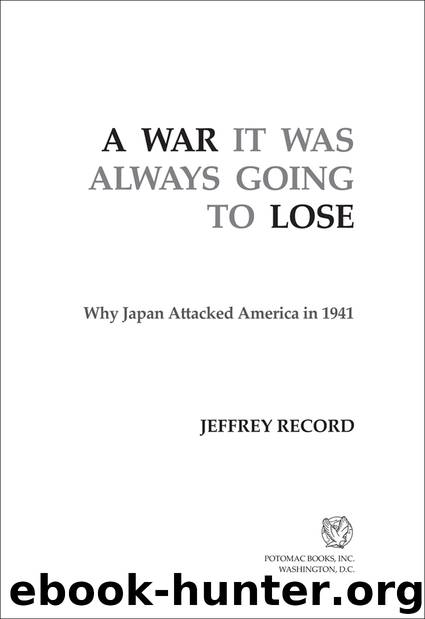A War It Was Always Going to Lose by Jeffrey Record

Author:Jeffrey Record
Language: eng
Format: epub
Publisher: Potomac Books, Inc.
Published: 2011-03-19T16:00:00+00:00
Planning and training for the attack on Pearl Harbor had begun in early 1941, when Admiral Yamamoto became commander in chief of Japan’s Combined Fleet. The final operational plan itself was approved at the September 6 Imperial Conference, and elements of Admiral Chuichi Nagumo’s Pearl Harbor strike force began departing Kure naval base on November 10. Ironically, given the strategic consequences of the decision for war with the United States, the attack on Pearl Harbor was much less militarily effective than it could have been. None of the U.S. Pacific Fleet’s three aircraft carriers was present at Pearl Harbor on December 7, 1941 (the Saratoga was on the West Coast, the Enterprise near Wake Island, and the Lexington off Midway Island). Of the eight mostly over-aged battleships at Pearl only two (the Arizona and Oklahoma) were destroyed beyond repair; the rest were refloated, repaired, and returned to wartime service. The same was true of the three light cruisers and four destroyers damaged in the attack. All U.S. heavy cruisers and submarines, and most U.S. destroyers, escaped any damage. Moreover, most of the 155 U.S. combat aircraft destroyed in Hawaii were replaced from the United States mainland within a matter of weeks.80 Worse still for the Japanese was their failure to destroy Pearl Harbor as a functioning naval base. (The attack was directed against the fleet, not the harbor.) Shore installations, including machine shops and the tremendous oil storage facility adjacent to Pearl Harbor, were left pretty much intact, which permitted the U.S. Navy to continue to operate from Pearl Harbor.
Gordon Prange believed that Nagumo’s failure to “pulverize the Pearl Harbor base” and “to seek out and sink America’s carriers” was Japan’s “first and probably greatest strategic error of the entire Pacific conflict.”81 The destruction of Pearl Harbor or the invasion and occupation of the Hawaiian Islands would have compelled the navy to operate from the American West Coast, adding another three thousand miles of distance to be surmounted before grappling with the Japanese in the Central and Southwestern Pacific. After the war, Minoru Genda, the brilliant Japanese naval aviator who planned the details of the attack on Pearl Harbor, lamented the Japanese failure to invade Hawaii, which he blamed on the IJA’s preoccupation with eventual war against the Soviet Union and unwillingness to release (from Manchuria) the divisions necessary to take Hawaii. “After the attack on Pearl Harbor,” he said, “we could have taken Honolulu pretty easily. This would have deprived the American Navy of its best island base in the Pacific [and] would have cut the lifeline to Australia, and that country might have fallen to us like a ripe plum.”82 Japanese possession of Hawaii and Australia would have deprived the United States of the indispensable base from which to challenge Japanese control of Southeast Asia.
Yet Yamamoto’s objective in the Pearl Harbor attack was limited: to knock out the U.S. Pacific Fleet for at least six months so that Japan could conquer Southeast Asia without American naval interference. Pearl
Download
This site does not store any files on its server. We only index and link to content provided by other sites. Please contact the content providers to delete copyright contents if any and email us, we'll remove relevant links or contents immediately.
| Arms Control | Diplomacy |
| Security | Trades & Tariffs |
| Treaties | African |
| Asian | Australian & Oceanian |
| Canadian | Caribbean & Latin American |
| European | Middle Eastern |
| Russian & Former Soviet Union |
The Secret History by Donna Tartt(16762)
The Social Justice Warrior Handbook by Lisa De Pasquale(11517)
Thirteen Reasons Why by Jay Asher(7857)
This Is How You Lose Her by Junot Diaz(5845)
Weapons of Math Destruction by Cathy O'Neil(5096)
Zero to One by Peter Thiel(4889)
The Myth of the Strong Leader by Archie Brown(4823)
Promise Me, Dad by Joe Biden(4495)
Beartown by Fredrik Backman(4491)
How Democracies Die by Steven Levitsky & Daniel Ziblatt(4469)
Stone's Rules by Roger Stone(4458)
The Fire Next Time by James Baldwin(4401)
100 Deadly Skills by Clint Emerson(4130)
A Higher Loyalty: Truth, Lies, and Leadership by James Comey(4076)
Rise and Kill First by Ronen Bergman(4066)
The David Icke Guide to the Global Conspiracy (and how to end it) by David Icke(3935)
The Farm by Tom Rob Smith(3912)
Secrecy World by Jake Bernstein(3829)
The Doomsday Machine by Daniel Ellsberg(3775)
